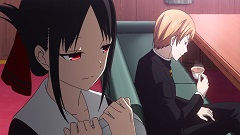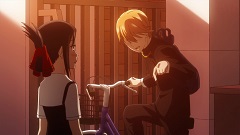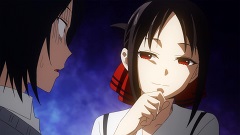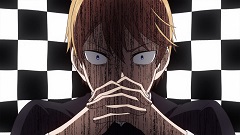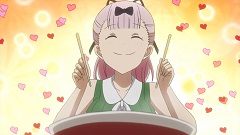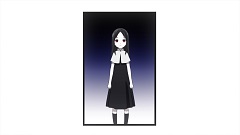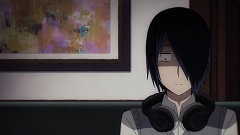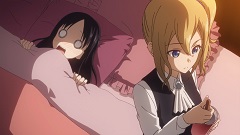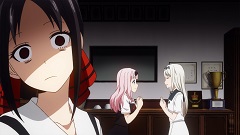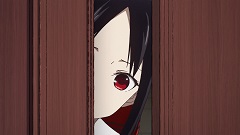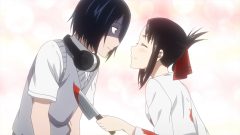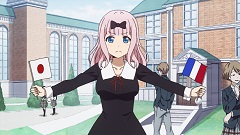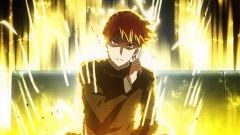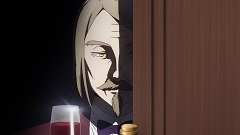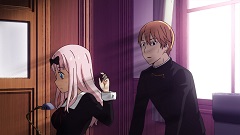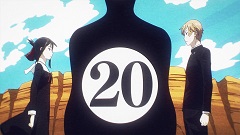Anime draws on many different media types in its endless search for properties to adapt, but manga is still the king of the bunch. And why not? It’s a distinctly Japanese art form, their main demographics have significant overlap, and manga’s panel-based layout means that some of the anime staff’s work is already done. Plenty of adaptations stick very closely to their manga counterparts (hopefully out of respect for the original), but some receive bold reinterpretations. Kaguya-sama doesn’t go quite that far, but under the guidance of director Mamoru Hatakeyama, it does manage to take on a life beyond that of its source material. Hatakeyama’s work on screwball comedies with Studio Shaft near the start of the decade gave him an eye for tricky camera positioning and outrageous character expressions. Since the show came to a conclusion several days ago, I’ve been skimming the manga and noticing the ways in which he embellished scenes by making full use of the student council room, where at least half the anime takes place. This is probably why that environment is rendered using cel-shaded 3D models, since it would allow extra freedom in deciding which angle of the room to capture.
Kaguya-sama’s move to television works to its benefit in plenty of other ways, as well. Its comic timing is terrific – I vividly remember the moment when a dump truck unloaded a towering pile of flowers directly onto Kaguya’s head. The slow, quiet manner in which the petals piled around her sold not just that scene, but a whole seven-minute segment. Things get loud when they need to, as well, with each battle of wits between Kaguya and Shirogane feeling more critical than the next. The show’s use of bright red and blue backgrounds (representing the two main characters) and urgent string accompaniments pushes their mental matches to absurd heights, only to bring them crashing down when fan favorite Fujiwara unwittingly interferes. Special mention must also be made of the series’ stellar casting, which put newcomer Aoi Koga in the lead role and reaped immense rewards as a result. Her blend of haughtiness and vulnerability made Kaguya my favorite character by a mile, but the other student council members had great actors behind them, as well. Even Ishigami, who I wasn’t originally fond of, found his stride once Ryouta Suzuki embraced the bitter, world-weary nerd at the heart of his character.
All these elements made Kaguya-sama successful as a comedy, but director Hatakeyama’s experience with drama paid off as well. Having headed up the masterful Shouwa Genroku Rakugo Shinjuu, he clearly knows how to frame more serious material. The two-part finale “I Can’t Hear the Fireworks,” which dug deep into Kaguya’s isolation and sorrow, is all the evidence one might require to support that claim. The moments when she reunites with her friends and realizes the depth of her affection for Shirogane are among the most heart-stopping in recent romcom history. Towering though that achievement may be, though, the blending of comedy and romance in simpler scenes also carried a kernel of drama, which was crucial in constructing a plausible on-screen relationship. Tropes like shared umbrellas and backseat bicycle rides felt more satisfying in Kaguya-sama than in other series, since Shirogane and Kaguya’s famed intellects gave way to their passion at just the right moments. Not all of these scenes were perfect – I had my reservations about a couple chapters near the end of the show’s run – but the hit-to-miss ratio favored the former by a sizable margin.
So what’s the final verdict? That’s up to each viewer to decide individually, but mine is quite positive. The comedy is clever and visually inventive, the romance is cute, and the dramatic conclusion alone is worth the price of entry. In fact, the series was so good out of the gate that my expectations went soaring for the second half, which didn’t always meet them. Still, I enjoyed my time with Kaguya-sama, and if you like shows that skillfully walk the line between silliness and sweetness, I think you will, too. It might not be on par with the Kare Kanos or Toradoras of anime, but it’s a thoughtfully-directed romantic comedy that ought to be watched by fans of the genre.

